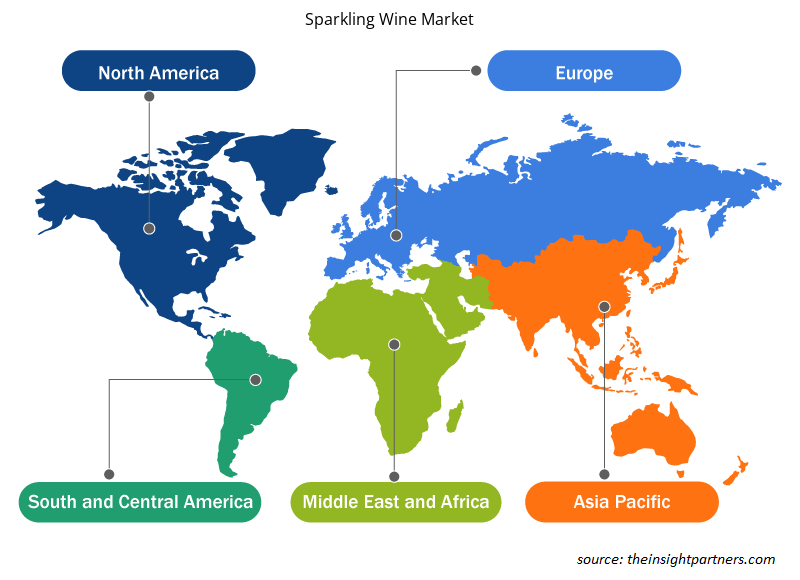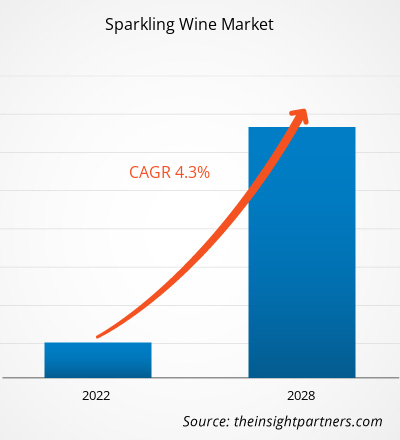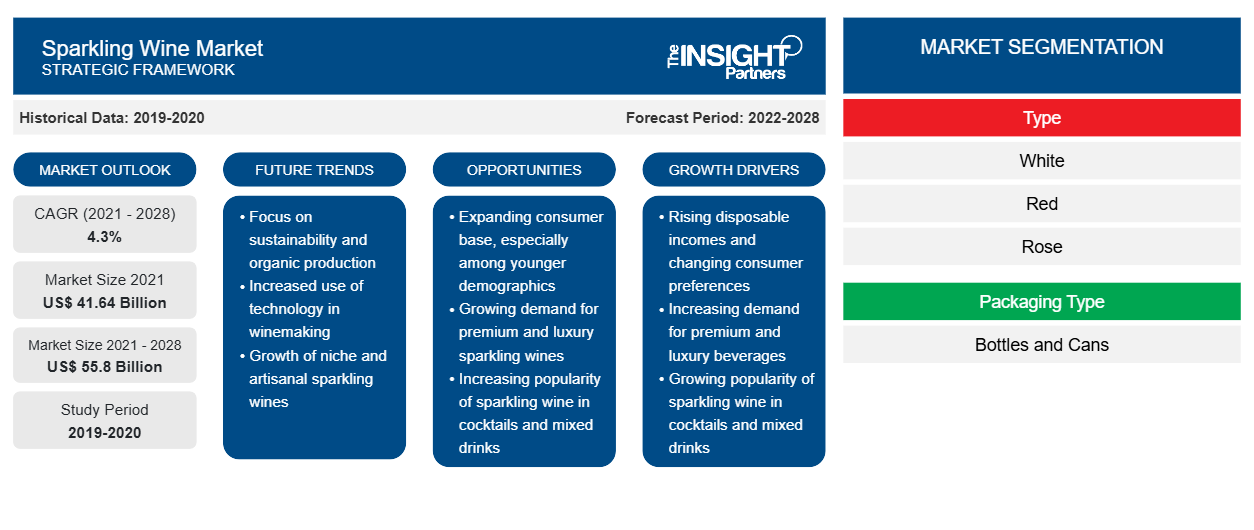2021 年起泡酒市场价值为 416.4 亿美元,预计到 2028 年将达到 558 亿美元;预计 2021 年至 2028 年的复合年增长率为 4.3%。
起泡酒是一种二氧化碳含量较高的葡萄酒,可以产生额外的气泡。香槟是最受欢迎的起泡酒类型之一。它是法国香槟地区生产的葡萄酒;然而,美国的许多起泡酒制造商都用这个名字来称呼他们当地生产的产品。
2020 年,欧洲占据了起泡酒市场的最大份额。欧盟 (EU) 是起泡酒生产商最集中的地方。根据葡萄酒与葡萄研究所的数据,自 2000 年以来,欧盟占全球起泡酒产量的 70-80%。据业内专家介绍,欧洲在国际市场上出口的起泡酒比静止葡萄酒多。该地区的酿酒历史悠久而辉煌。世界各地的葡萄酒爱好者都喜欢欧洲起泡酒,因为它们具有独特的风味、口味和制备方法。此外,人们对低酒精饮料的偏好日益增加、名人对人们生活方式的影响力日益增强、对方便食品和饮料的倾向、以及在节日和庆祝活动期间开一瓶香槟或起泡酒的传统等,都证明了对这类葡萄酒的需求急剧增加是合理的。欧洲有一个高度成熟的起泡酒市场,其中包括几家知名和小型酿酒厂。
在新冠疫情期间,工人短缺严重影响了起泡酒生产商的生产能力。此外,批发市场的关闭也迫使制造商主要依赖超市和电子商务经销商来销售起泡酒产品。尽管疫情肆虐,但玫瑰红葡萄酒和起泡酒的销量仍有所增长。
定制此报告以满足您的需求
您可以免费定制任何报告,包括本报告的部分内容、国家级分析、Excel 数据包,以及为初创企业和大学提供优惠和折扣
-
获取此报告的关键市场趋势。这个免费样品将包括数据分析,从市场趋势到估计和预测。
市场洞察
起泡酒越来越受欢迎
快速的社会经济变化和快速的城市化正在推动对起泡酒的需求。随着生活水平和购买力的不断提高,客户渴望购买高品质的奢侈品。此外,他们的饮食习惯和用餐偏好也随着生活方式的变化而变化。因此,派对、婚礼和社交聚会对起泡酒的需求正在上升。随着人们对低酒精或无酒精饮料的偏好日益增加,这种葡萄酒在千禧一代、青少年和工作人群以及单身汉和住在旅馆的人中的受欢迎程度正在提高。此外,社交媒体和互联网的广泛使用对所有世代都产生了重大影响,而派对和社交活动数量的增加也导致全球起泡酒消费量增加,主要是在美国、加拿大、墨西哥、德国、法国和意大利等发达国家,从而推动了起泡酒市场的增长。
类型洞察
根据类型,起泡酒市场分为红葡萄酒、白葡萄酒和玫瑰红葡萄酒。2020 年,白葡萄酒占据了最大的市场份额。白葡萄酒采用意大利皮埃蒙特葡萄酒产区的 Moscato Bianco 葡萄酿制而成。其产地主要集中在意大利北部的阿尔巴和阿斯蒂省。气泡是由自然发酵引起的,这种发酵可能发生在瓶子或大罐中。发酵发生在将糖添加到葡萄酒中,酵母作用于糖并产生二氧化碳时。气泡是由于封闭环境中的二氧化碳被困在葡萄酒中而形成的。
百加得有限公司 (Bacardi & Company Limited)、Bronco Wine Co.、卡塞拉 (Casella)、星座品牌公司 (Constellation Brands, Inc.)、汉凯尔弗雷克斯奈特 (Henkell Freixenet)、香栋 (Chandon)、Schramsberg Wineyards、保乐力加酿酒商 (Pernod Ricard Winemakers)、The Sparkling Wine Co.、Treasury Wine Estates Ltd、Bottega Spa、金巴利集团 (Campari Group) 和 Codorniu 是起泡酒市场的主要参与者。
起泡酒市场区域洞察
Insight Partners 的分析师已详细解释了预测期内影响起泡酒市场的区域趋势和因素。本节还讨论了北美、欧洲、亚太地区、中东和非洲以及南美和中美洲的起泡酒市场细分和地理位置。

- 获取起泡酒市场的区域具体数据
起泡酒市场报告范围
| 报告属性 | 细节 |
|---|---|
| 2021 年市场规模 | 416.4亿美元 |
| 2028 年市场规模 | 558亿美元 |
| 全球复合年增长率(2021 - 2028) | 4.3% |
| 史料 | 2019-2020 |
| 预测期 | 2022-2028 |
| 涵盖的领域 |
按类型
|
| 覆盖地区和国家 |
北美
|
| 市场领导者和主要公司简介 |
|
起泡酒市场参与者密度:了解其对商业动态的影响
起泡酒市场正在快速增长,这得益于终端用户需求的不断增长,而这些需求又源于消费者偏好的不断变化、技术进步以及对产品优势的认识不断提高等因素。随着需求的增加,企业正在扩大其产品范围,进行创新以满足消费者的需求,并利用新兴趋势,从而进一步推动市场增长。
市场参与者密度是指在特定市场或行业内运营的企业或公司的分布情况。它表明在给定市场空间中,相对于其规模或总市场价值,有多少竞争对手(市场参与者)存在。
在起泡酒市场运营的主要公司有:
- 百加得有限公司
- 野马葡萄酒公司
- 卡塞拉
- 星座品牌公司
- 汉凯尔快运
免责声明:上面列出的公司没有按照任何特定顺序排列。

- 了解起泡酒市场主要参与者概况
报告亮点
- 全球起泡酒市场的渐进式行业趋势,帮助参与者制定有效的长期战略
- 发达市场和发展中市场公司采用的业务增长战略
- 2019 年至 2028 年全球起泡酒市场定量分析
- 消费者对起泡酒的需求估计
- PEST 分析可说明行业内买家和供应商预测市场增长的有效性
- 了解竞争激烈的市场形势和对起泡酒的需求的最新发展
- 市场趋势和前景以及推动和抑制起泡酒市场增长的因素
- 了解支撑市场商业利益的战略,从而协助市场参与者的决策过程
- 不同市场节点的起泡酒市场规模
- 全球起泡酒市场的详细概述和细分,以及其行业动态
- 各地区起泡酒市场规模及增长机遇
起泡酒市场(按类型)
- 白色的
- 红色的
- 玫瑰
起泡酒市场(按包装类型)
- 瓶子
- 罐头
起泡酒市场,按分销渠道划分
- 超市和大卖场
- 专卖店
- 网上零售
- 其他的
公司简介
- 百加得有限公司
- 野马葡萄酒公司
- 卡塞拉
- 星座品牌公司
- 汉凯尔快运
- 施拉姆斯堡酒庄
- 保乐力加酿酒师
- 起泡葡萄酒公司
- 富邑葡萄酒集团
- 香冬
- 历史分析(2 年)、基准年、预测(7 年)及复合年增长率
- PEST和SWOT分析
- 市场规模、价值/数量 - 全球、区域、国家
- 行业和竞争格局
- Excel 数据集
近期报告
相关报告
客户评价
购买理由
- 明智的决策
- 了解市场动态
- 竞争分析
- 客户洞察
- 市场预测
- 风险规避
- 战略规划
- 投资论证
- 识别新兴市场
- 优化营销策略
- 提升运营效率
- 顺应监管趋势























 获取免费样品 - 起泡酒市场
获取免费样品 - 起泡酒市场